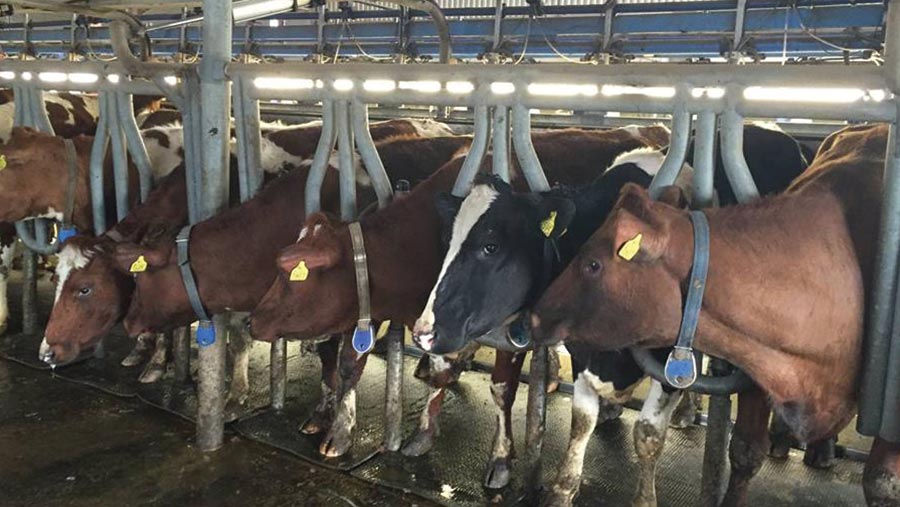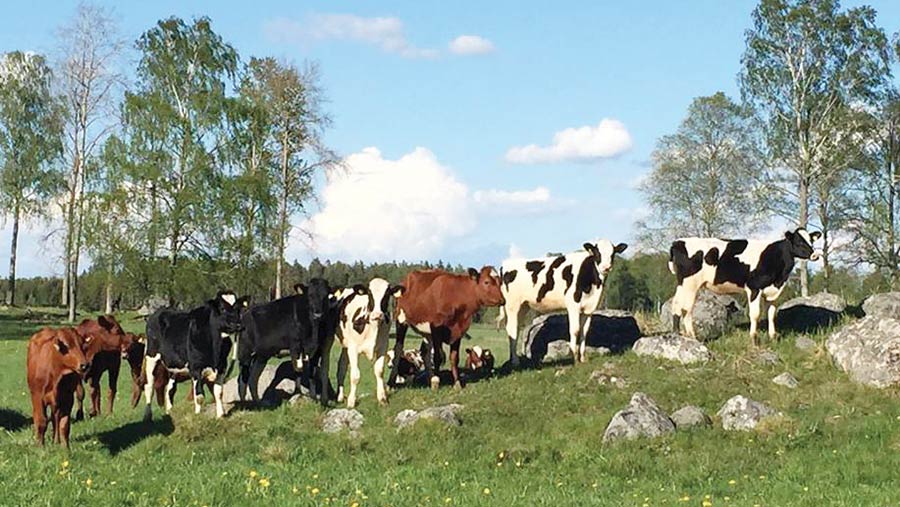4 ways Sweden has cut antibiotics use on dairy farms

UK livestock producers have been committed to – and successful in – meeting government targets on antibiotic usage over recent years, but Sweden is still leading the way.
A 2017 EU report concluded that the country consistently records the lowest use of veterinary antimicrobials among EU member states, suggesting there is room for improvement in the UK.
Ylva Persson, associate state veterinarian at the Swedish Veterinarian Association, explains how the country is achieving this and offers advice on how UK farmers can aspire to do the same.
More on antibiotics and advice on how you can cut their use
- Sector-specific antibiotics targets and what they mean
- How Dutch farmers reduced antibiotics use by 60%
- How a Somerset dairy farm slashed antibiotic use
- 7 ways a sheep farmer has cut antibiotics use
- Thermal imaging cuts antibiotics use on Northants beef farm
- 5 steps to reduce antibiotics use in your pig herd
- 4 ways Sweden has cut antibiotics use on dairy farms
- 4 ways US dairy has cut antibiotics in lactating cows
- How a farmer tackled watery mouth without antibiotics
1. Remove unnecessary use
Sweden has historically been ahead of the game in terms of minimising antibiotic usage, with the country banning antibiotics as growth promoters back in 1986 – 20 years before this practice was prohibited by the EU.
Since then, farmers and the government have continued to work towards prudent use of antimicrobial treatment, which has helped keep overall usage at a very low level.
According to the 2016 European Surveillance of Veterinary Antimicrobial Consumption report, total sales of veterinary antimicrobial agents in Sweden fell from 15.2mg/Population Correction Unit (PCU) in 2010 to 12.1mg/PCU in 2016.
To put this in perspective, while UK usage fell over the same period – from 61.7mg/PCU in 2015 – the total sales in 2016 were still as high as 45mg/PCU.
How are they achieving this?
- Reducing prophylactic use.
- Selective dry cow therapy: individual treatment is standard for both cows and calves.
- Treating acute cases of mastitis only: all other cases – such as subclinical – are treated with supportive therapy such as anti-inflammatories.
- Vets cannot sell antibiotic treatments they prescribe, and farmers cannot treat their own animals. Instead, vets administer drugs.
2. Minimise need and prevent spread
In Sweden, the dairy sector mantra is that prevention is better than cure, meaning good biosecurity and infection control is crucial.
As well as needing lower antibiotic usage, healthy cows also mean better animal welfare, easier farm labour, more milk and improved growth rates, leading to overall better profitability.
How are they achieving this?
- Cattle are free from infectious diseases such as BVD, IBR, paratuberculosis, brucellosis, chlamydia, leptospirosis, tuberculosis and leucosis.
- Low counts of infectious foot diseases, with just 1% of the national herd affected.
- Low rates of digital dermatitis, affecting about 3.5% of the national herd.
- Treatment of clinical mastitis is about 7.3%.
- Following the 5:2 “diet” for slimming cell counts (see below).

3. Optimise use when needed
Undoubtedly, some cases do require antibiotic treatment.
When these situations arise, it is still possible to keep treatment to a minimum by being confident in the diagnosis and then selecting the most suitable treatment and optimising dosage and treatment length.
How are they achieving this?
- Guidelines from the SVA recommend penicillin as the first-choice treatment in most cases.
- Legislation enforced by the government restricts the use of quinolones and new-generation cephalosporins.
- Narrow-spectrum antibiotics are used where possible.
- They avoid the use of the most critically important antibiotics (fluoroquinolones, third-fourth generation cephalosporins, macrolides).
- Milk samples for every case of mastitis are collected by vets to determine the causal pathogen and decide the appropriate treatment.
- Where gram-positives are responsible for mastitis, a course of penicillin is used for three to five days.
- Chronic-mastitis cows are culled rather than treated, because of the very low chance of recovery.
- Mastitis caused by staphylococcus with beta-lactamase production is not treated, because of penicillin resistance. Instead, cows are culled.
- Salicylic acid and bandages are used to treat infectious foot and claw diseases.
- For reproductive disorders, antibiotic treatment is reserved for acute clinical metritis only.
4. Monitoring use and resistance
Recording and benchmarking is another important factor in keeping antibiotic usage low.
Because of this accurate monitoring, the resistance picture remains extremely favourable in Sweden, with very few resistant bacteria in the dairy sector.
Penicillin resistance to staphylococcus aureus – something that is a major concern for the dairy industry – now stands at about 2% for clinical mastitis. Therefore, penicillin is used only when absolutely necessary.
How are they achieving this?
- Vets have to record treatment incidences and causal pathogens.
- Online platforms available to farmers through the national cow recording scheme allow them to monitor their own herd health and medicine usage as well as benchmarking against other farmers.
- Regular co-operation with the government, vets and dairy farmers to ensure targets are being met.
The 5:2 ‘diet’ to slim cell counts
Adopted from the famous 5:2 slimming method, Sweden has introduced a 5:2 approach to help farmers minimise their cell counts and improve udder health.
Five routines to stop the spread of contagious bacteria
- Optimal milking routines
- Teat dip
- Using selective dry cow therapy
- Treating the “right cows” – ones with signs of high SCC (>200,00) – during lactation
- Grouping and culling chronically infected cows
Two routines to stop the spread of environmental pathogens
- Good hygiene
- Strict biosecurity to boost cow immunity
Top tips for UK farmers
Though UK farmers are already making strides in improving antibiotic usage, there are a number of practical measures that can be taken from Swedish farming practices to help lower on-farm use:
- Put a greater focus on biosecurity, hygiene and infection control to minimise the risk of infection entering the herd.
- Use selective therapy instead of group treatment to ensure only sick cows receive treatment.
- Cull chronic-mastitis cows – repeated treatment is likely to be ineffective.
- Use supportive therapy – such as anti-inflammatories – instead of antibiotics where possible.
- Avoid the usage of critically important antibiotics.
- Make better use of recording and benchmarking to help keep track of individual farm antibiotic usage.
